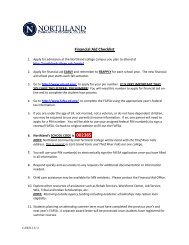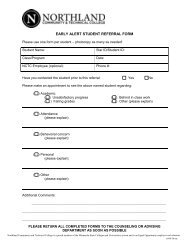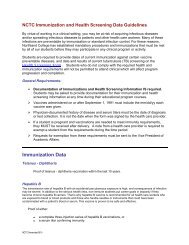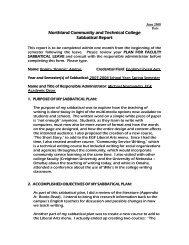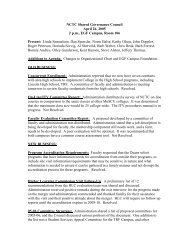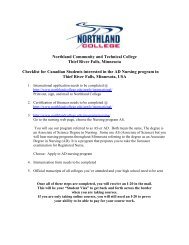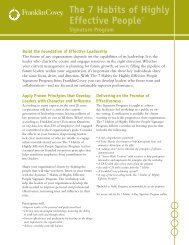OT's Role in Treatment of Anorexia Nervosa by Jessica Brown
OT's Role in Treatment of Anorexia Nervosa by Jessica Brown
OT's Role in Treatment of Anorexia Nervosa by Jessica Brown
You also want an ePaper? Increase the reach of your titles
YUMPU automatically turns print PDFs into web optimized ePapers that Google loves.
weight loss without evidence <strong>of</strong> any other illness expla<strong>in</strong><strong>in</strong>g weight loss, and failure tomenstruate. Psychological characteristics <strong>in</strong>clude; obsessive concern about weight anddiet<strong>in</strong>g, unrealistic perception <strong>of</strong> be<strong>in</strong>g fat, and an extreme fear <strong>of</strong> ga<strong>in</strong><strong>in</strong>g weight.Behavioral characteristics <strong>in</strong>clude; excessive physical exercise which patient may deny,avoidance or shar<strong>in</strong>g meal times with others, cutt<strong>in</strong>g out foods they once enjoyed, andvomit<strong>in</strong>g and laxatives.<strong>Treatment</strong> <strong>of</strong> patients is very <strong>in</strong>dividual based so it is best to <strong>in</strong>volve the patient andfamily at 1 st contact. It is also important to be sensitive and flexible to the needs <strong>of</strong> thepatient and <strong>in</strong>volve the patient <strong>in</strong> every aspect <strong>of</strong> the treatment process. <strong>Treatment</strong> goals<strong>in</strong>clude; restor<strong>in</strong>g body weight and correct<strong>in</strong>g malnutrition, correct<strong>in</strong>g dysfunctionalbehaviors and th<strong>in</strong>k<strong>in</strong>g, treat depression and obsessive th<strong>in</strong>k<strong>in</strong>g, restor<strong>in</strong>g autonomy,prevent relapse, and support the family and partner.Level V: <strong>Anorexia</strong> <strong>Nervosa</strong> and Reynaud’s phenomenon: A case report.Reynaud’s phenomenon is a syndrome characterized <strong>by</strong> episodic digital ischemia<strong>in</strong> which discoloration <strong>of</strong> the digits follows a characteristic pattern <strong>in</strong> time from white toblue to red. Emotional stress is recognized as a trigger. This case report discusses the l<strong>in</strong>kbetween Reynaud’s and anorexia nervosa are m<strong>in</strong>imal. Two forms have been identified: anidiopathic form (Raynaud’s disease), which is not associated with other diseases, causesvasospasm and the second form is associated with other systemic diseases that have beenwell described causes <strong>of</strong> Raynaud’s disease.The case <strong>in</strong> this article describes a 19 year old woman, 160cm tall, her weight is 35 kg, herbody mass <strong>in</strong>dex be<strong>in</strong>g 13.6kg/m. She expressed a sign cant fear <strong>of</strong> be<strong>in</strong>g fat and two yearsprior with a weight <strong>of</strong> 55kg. She started a strict diet and exercise program. At first whenadmitted she was diagnosed with <strong>Anorexia</strong> <strong>Nervosa</strong>, restricted type. In accordance withher weight loss she described feel<strong>in</strong>g cold and that her hands and feet turned white orpurple due to cold temperatures. This patient underwent further test<strong>in</strong>g <strong>in</strong>dicat<strong>in</strong>g she <strong>in</strong>fact had Reynaud’s phenomenon.Dur<strong>in</strong>g the first 18 month evaluation the patient’s body dimorphic thoughts had subsidedtest<strong>in</strong>g <strong>in</strong>dicated hypogonadotrphic hypogonadism. By the third year her amenorrhea wasstill go<strong>in</strong>g on so transdermal estrogen replacement therapy.More research should be established on the approach <strong>of</strong> anorexia nervosa and theReynaud’s phenomenon that they may be <strong>in</strong>tertw<strong>in</strong>ed and may help <strong>in</strong> a therapeuticapproach to the treatment <strong>of</strong> anorexia nervosa.Level V: Cognitive Behavioural Therapy for <strong>in</strong>dividuals with longstand<strong>in</strong>g anorexianervosa: adaptations, cl<strong>in</strong>ician survival and system issues.Cognitive Behavioral Therapy is recognized as the treatment <strong>of</strong> choice for patientswith eat<strong>in</strong>g disorders. Strong evidence based research is show<strong>in</strong>g the effectiveness <strong>of</strong> CBT<strong>in</strong> bulimia nervosa but it is not as strong for anorexia nervosa. <strong>Anorexia</strong> is widely known tobe the most difficult psychiatric disorder to treat and us<strong>in</strong>g the traditional CBT techniqueshas been found to be more <strong>of</strong> a challenge. Some <strong>of</strong> the most important skills needed to havesuccess <strong>in</strong> treat<strong>in</strong>g a patient with anorexia nervosa is gett<strong>in</strong>g the patient <strong>in</strong>volved <strong>by</strong>form<strong>in</strong>g a strong therapeutic alliance with an emphasis on consistency, encouragement,reassurance and patience(Bamford & Mountford, 2012).Therapists need to take <strong>in</strong>to consideration they should never rush a patient <strong>in</strong>to



